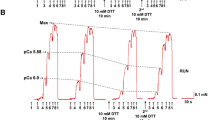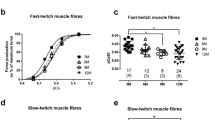Summary
The effects on selected histochemical and morphological parameters of anabolic steroid administration and of high-intensity sprint running, separately, and in combination, were studied in young adult male rats. Dianabol (methandrostenolone) 1 mg/day for 8 weeks had no significant effects on phosphorylase or glycogen staining intensities and on fiber area in skeletal muscles of either trained or sedentary animals. The program of sprint training resulted in significantly decreased intensities of phosphorylase in all ten regions of the gastrocnemius, plantaris, and soleus muscles that were studied. Glycogen localization was significantly increased with training in five regions of the gastrocnemius and plantaris muscles which contained predominantly fast-twitch fibers. No changes in fiber area occurred with the training program. We conclude from these results that (a) normal androgen levels in young, healthy male animals are sufficiently high so that the intake of large doses of anabolic steroid does not result in the stimulation of glycogen metabolism or hypertrophy of skeletal muscle; (b) the changes induced by high-intensity, short-duration sprint training suggest that the existing glycolytic capacity of muscle is adequate to supply the muscles energy needs even during the stress of very strenuous exercise, and that more fast-twitch fibers were recruited by the exercise regimen than slow-twitch fibers.
Similar content being viewed by others
References
Ariano, M. A., Armstrong, R. B., Edgerton, V. R.: Hindlimb muscle fiber populations of five mammals. J. Histochem. Cytochem. 21, 51–55 (1973)
Baldwin, K. M., Klinkerfuss, G. H., Terjung, R. L., Molé, P. A., Holloszy, J. O.: Respiratory capacity of white, red, and intermediate muscle: adaptive response to exercise. Amer. J. Physiol. 222, 373–378 (1972)
Baldwin, K. M., Winder, W. W., Terjung, R. L., Holloszy, J. O.: Glycolytic enzymes in different types of skeletal muscle: adaptation to exercise. Amer. J. Physiol. 225, 962–966 (1973)
Barnard, R. J., Edgerton, V. R., Furukawa, T., Peter, J. B.: Histochemical, biochemical and contractile properties of red, white and intermediate fibers. Amer. J. Physiol. 220, 410–414 (1971)
Bergamini, E.: Different mechanisms in testosterone action on glycogen metabolism in rat perineal and skeletal muscles. Endocrinology 96, 77–84 (1975)
Bergamini, E., Bombara, G., Pellegrino, C.: The effect of testosterone on glycogen metabolism in rat levator ani muscle. Biochim. biophys. Acta (Amst.) 177, 220–234 (1969)
Boris, A., Stevenson, R. H., Trmal, T.: Comparative androgenic, myotropic and antigonadotrophic properties of some anabolic steroids. Steroids 15, 61–71 (1970)
Brown, B. S., Van Huss, W. D.: Exercise and rat brain catecholamines. J. appl. Physiol. 34, 664–669 (1973)
Exner, G. U., Staudte, H. W., Pette, D.: Isometric training of rats — effects upon fast and slow muscle and modification by an anabolic hormone (Nandrolone Decanoate). I. Female rats. Pflügers Arch. 345, 1–14 (1973a)
Exner, G. U., Staudte, H. W., Pette, D.: Isometric training of rats — effects upon fast and slow muscle and modification by an anabolic hormone (Nandrolone Decanoate). II. Male rats. Pflügers Arch. 345, 15–22 (1973b)
Gauthier, G. F.: The ultrastructure of three fiber types in mammalian skeletal muscle. In: The physiology and biochemistry of muscle as a food, 2nd ed. (E. J. Briskey, R. G. Cassens, B. B. Marsh, eds), pp. 103–130. Madison: University of Wisconsin Press 1970
Gillespie, C. A., Edgerton, V. R.: The role of testosterone in exercise-induced glycogen supercompensation. Horm. Metab. Res. 2, 364–366 (1970)
Gollnick, P. D., Hermanson, L.: Biochemical adaptations to exercise: anaerobic metabolism. In: Exercise and sports sciences reviews, Vol. I (J. H. Wilmore, ed.), pp. 1–43. New York-London: Academic Press 1973
Lamb, D. R., Peter, J. B., Jeffress, R. N., Wallace, H. A.: Glycogen, hexokinase, and glycogen synthetase adaptations to exercise. Amer. J. Physiol. 217, 1628–1632 (1969)
Leonard, S. L.: A glycostatic effect of testosterone on the perineal muscles of the rat. Endocrinology 50, 199–205 (1952a)
Leonard, S. L.: The effect of castration and testosterone propionate injection on glycogen storage in skeletal muscle. Endocrinology 51, 293–297 (1952b)
Lewis, L. A., McCullagh, E. P.: Carbohydrate metabolism of animals treated with methyl testosterone and testosterone propionate. J. clin. Endocr. 2, 502–506 (1942)
Meyer, R. H., Hershberger, L. G.: Effects of testosterone administration on acid soluble and insoluble glycogen in the levator ani muscle. Endocrinology 60, 397–402 (1957)
Peter, J. B., Barnard, R. J., Edgerton, V. R., Gillespie, C. A., Stempel, K. E.: Metabolic profiles of three fiber types of skeletal muscle in guinea pigs and rabbits. Biochemistry 11, 2627–2633 (1972)
Ruhling, R. O., Van Huss, W. D., Heusner, W. W., Carrow, R. E., Sleight, S. D.: Histochemical and morphological observations on rat myocardium after exercise. Int. Z. angew. Physiol. 31, 305–313 (1973)
Saubert, IV, C. W., Armstrong, R. B., Shepherd, R. E., Gollnick, P. D.: Anaerobic enzyme adaptations to sprint training in rats. Pflügers Arch. 341, 305–312 (1972)
Shields, R. P., Whitehair, C. K., Carrow, R. E., Heusner, W. W., Van Huss, W. D.: Skeletal muscle function and structure after depletion of creatine. Lab. Invest. 33, 151–158 (1975)
Staudte, H. W., Exner, G. U., Pette, D.: Effects of short-term, high-intensity (sprint) training on some contractile and metabolic characeristics of fast and slow muscle of the rat. Pflügers Arch. 344, 159–168 (1973)
Stein, J. M., Padykula, H. A.: Histochemical classification of individual skeletal muscle fibers in the rat. Amer. J. Anat. 110, 103–123 (1962)
Takeuchi, F.: Histochemical demonstration of branching enzyme (amylo-1–4, 1–6-transglucosidase) in animal tissues. J. Histochem. Cytochem. 6, 208–216 (1958)
Terjung, R. L., Baldwin, K. M., Winder, W. W., Holloszy, J. O.: Glycogen repletion in different types of muscle and in liver after exhausting exercise. Amer. J. Physiol. 226, 1387–1391 (1974)
Wells, R. L., Heusner, W. W.: A controlled-running wheel for small animals. Lab. Anim. Sci. 21, 904–910 (1971)
Author information
Authors and Affiliations
Rights and permissions
About this article
Cite this article
Hickson, R.C., Heusner, W.W., Van Huss, W.D. et al. Effects of an anabolic steroid and sprint training on selected histochemical and morphological observations in rat skeletal muscle types. Europ. J. Appl. Physiol. 35, 251–259 (1976). https://doi.org/10.1007/BF00423284
Received:
Issue Date:
DOI: https://doi.org/10.1007/BF00423284




